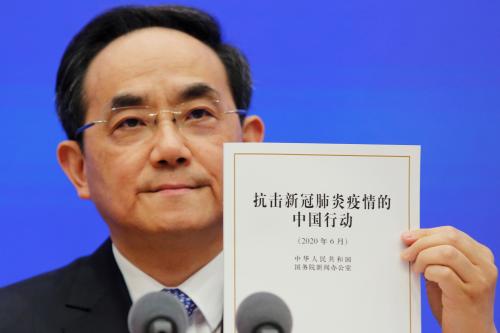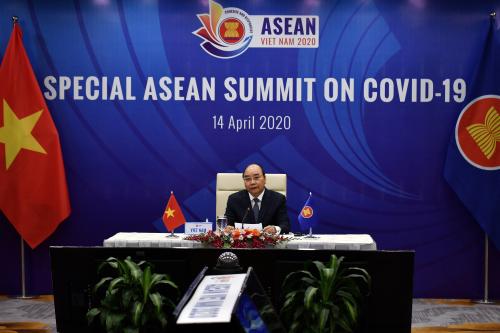COVID–19 has been disrupting economic activities around the world, and Southeast Asia is no exception. The effects of this pandemic are unequal. The region’s 2020 GDP is estimated to shrink by 4.2% overall, but the services sector — tourism especially — has been hit harder than the manufacturing sector. Small- and medium-sized enterprises (SMEs) have been suffering more than large firms. As a result, the Association of Southeast Asian Nations (ASEAN) introduced several initiatives meant to manage the crisis and ensure post-COVID recovery. While this is laudable, to more effectively facilitate economic recovery, ASEAN should operationalize an ASEAN small- and medium-sized enterprise recovery facility, opening special financing tools to such firms. It should also set up rules that ensure international flows of people, as well as address trade protectionism, which could hinder ASEAN’s recovery effort.
The region rises to meet the challenge
The challenges posed by COVID-19 have led ASEAN to convene several high-level meetings to discuss ways to respond to the pandemic and undertake regional economic recovery. For example, the Special ASEAN Summit in April 2020 created the COVID-19 ASEAN Response Fund, aimed at financing the procurement of necessary medical equipment and supplies to fight the virus. Also at this meeting, ASEAN governments pledged to work with one another, with non-ASEAN countries, and with international organizations to “maintain socio-economic stability while sustaining ASEAN Community building momentum for sustainable development, inclusive growth and leaving no one behind.” In June, leaders at the 36th ASEAN Summit announced the “ASEAN Leaders’ Vision Statement on A Cohesive and Responsive ASEAN.” The document expressed the member states’ “strong commitment to alleviate the adverse impact of the COVID19 pandemic on our people’s livelihood, societies and economies.”
Moreover, the recent 37th ASEAN Summit in November adopted the Declaration on an ASEAN Travel Corridor Arrangement Framework, which seeks to facilitate intra-ASEAN essential business travel while ensuring public health safety. This gathering also endorsed the ASEAN Comprehensive Recovery Framework (ACRF) and its implementation plan, which guide ASEAN towards post-COVID-19 recovery. The ACRF consists of five broad strategies: “(i) enhancing the health system; (ii) strengthening human security; (iii) maximising the potential of intra-ASEAN market and broader economic integration; (iv) accelerating inclusive digital transformation; and (v) advancing towards a more sustainable and resilient future.” The implementation plan contains several measures to be enacted, including bolstering transnational supply chain resilience; promoting e-commerce, the digital economy, and sustainable infrastructure; and exploring the development of an ASEAN SMEs recovery facility. The latter, once activated, would serve as “a multi-contributor and co-financing platform to provide financing facility and accelerate the recovery of” SMEs.
Alongside these COVID-specific initiatives, the Regional Comprehensive Economic Partnership (RCEP) was signed in November by the 10 ASEAN nations and five ASEAN dialogue partners — Australia, China, Japan, New Zealand, and South Korea. RCEP — the world’s biggest trading bloc to date — accounts for about $26 trillion in economic activity (or 30% of global GDP) and 28% of the world’s trade. While this pact awaits ratification by at least six ASEAN and three non-ASEAN members before entering into force, RCEP signing sends a positive signal to the markets. Specifically, it shows that these economies are committed to working together to deepen transnational supply chains amidst rising uncertainties caused by tensions among great powers and by the pandemic. Regarding the latter, the pact can further enable its members to diversify their production networks and leverage the digital economy, enhancing their economic resiliency and business confidence.
Where more can be done
Although the collective effort above is laudable, more work needs to be done. To more effectively facilitate economic reopening and recovery, ASEAN should accelerate and operationalize an ASEAN SMEs recovery facility soon. SMEs are the backbone of Southeast Asian economies: Depending on the country, they are about 89-99% percent of all businesses. Their contributions to each ASEAN state’s GDP ranges from 30% to 53%. Hence, the facility would not only help these firms recover, but also enable ASEAN to advance the ASEAN Economic Community — a regional economic integration project — in a more inclusive manner.
In the realm of international movement of people, the Declaration on an ASEAN Travel Corridor Agreement Framework limits travel to only essential business trips. Other types of overseas travel are still either restricted or banned. Concerning the international movement of migrant workers, COVID-19 has entailed border tightening. This does not bode well for Southeast Asia’s economies, which depend on a foreign workforce of about 10 million people. While a region-wide agreement may not be feasible right now, the governments that are party to the existing bilateral labor deals could work together to ensure smoother international flows. For example, they could start by lessening host countries’ misperceptions of foreign workers, as misunderstandings could fuel xenophobia and interrupt cross-border labor movements. Doing so will not only benefit host and home countries, but also enhance the region’s post-pandemic recovery.
A region-wide agreement on intra-ASEAN tourism would also help with recovery. Intra-ASEAN travel contributed to more than 40% of all trips made in the Asia-Pacific region, according to the 2019 figure. Such an arrangement would help the hard-hit tourism industry, and related industries, to better recuperate. Admittedly, such a region-wide deal is infeasible right now, mainly because Southeast Asian nations are at different stages of the pandemic. At the time of writing, while Vietnam and Singapore have largely kept the virus under control, Indonesia, Myanmar, and the Philippines are witnessing thousands of daily cases. However, while these nations wait for the virus to subside, they should prepare for the future by writing rules for a region-wide travel deal so that it can be quickly implemented when feasible. For example, they can do so by concocting a commonly agreed definition of virus-free tourists.
In addition, RCEP will not be able to effectively liberalize regional trade on its own. The prospect of protectionism looms large. The number of non-tariff barriers in Southeast Asia rose from about 2,000 in 2015 to 9,000 in 2019. As the pandemic continues to disrupt international economic activities and cause mass unemployment, the Southeast Asian governments are under mounting pressure to safeguard particular domestic interests at the expense of other countries. If left unchecked, these pressures could ultimately tempt authorities to roll out additional non-tariff barriers or employ new kinds of protectionism, hindering trade in the future.
Overall, facilitating economic recovery from the impact of COVID-19 is not an easy task. While ASEAN has introduced new initiatives to facilitate such a recovery, some challenges remain. Given the general uncertainties and the looming possibility of a new wave of the virus, it remains crucial that ASEAN members work together and embrace an open economic system in order to help the region weather the crisis. Inward-looking and protectionist stances will only make matters worse.
-
Acknowledgements and disclosures
Adrien Chorn provided editing assistance for this piece.







Commentary
ASEAN’s perspective on economic recovery
December 17, 2020